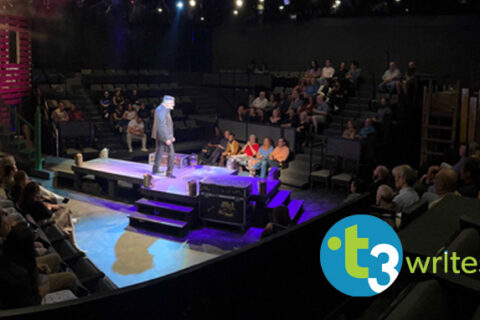Reduce, Reuse, Re-conceptualize
by Maxim Overton, Production Manager/ Master Electrician
It is my exciting privilege to announce to our Theatre Three community that Theatre Three has stepped forward as an industry leader to usher theatres into the 21st century by taking responsibility for our ecological footprint and allowing our guests and company members the satisfaction of recycling.
Whoop-de-doo.
We actually did this a few months ago. Over a month into quarantine, we’re getting into the backlogs of announcements. But it’s a notable thing, for two reasons. One, our Executive Director Charles Beavers finished hacking through the remaining red tape to make this possible. Kudos and many thanks to him. The second reason is that we’ve actually been re-using and recycling for decades. It’s about time the Dr. Pepper cans were included too.
Theatre is built on reusing and recycling. The longer you work with a specific company or attend their shows, the easier it is to spot the reusing. The same wine glasses at every dinner party. The same red dress from two seasons ago. Eventually, it becomes a game we play in the lobby during intermission. “Did you notice that she hit him with Dr. Jekyll’s cane?” “The last time they used that table was in The Odd Couple. I remember the linoleum.” “They must’ve taken The Ghost Of Christmas Present’s beard, spray painted it orange, and used it as that prostitute’s wig!”
The recycling is where things get fun. In college I once took a stray 9-Iron from Goodwill and turned it into a sci-fi rifle’s stock. I took the taped wrapping off the handle and bent the whole thing around a nearby newel post to keep it from crimping. This made a semi circle halfway down the shaft, so the club was now basically a long narrow ‘U.’ With the end of the handle now level with the head, I lashed the two together using the handle’s tape, adding more lashing down the line to make the first less conspicuous. I then drilled two holes on the top of the stock so that I could attach it to a skinny curtain rod poking out of a Super Soaker that I had worked on earlier. With some silver spray paint, the tiny pool toy pistol was now a post apocalyptic rifle. I went through all of that work because we had no budget. We were self-producing. It sounds desperate, and it sort of is, but damn was it fun re-conceptualizing an everyday object into something spectacular. Theatre producers develop an ability to see an object not only as the sum of its parts, but as the sum of its potential. We re-conceptualize to fit our need.
It comes from necessity. A show like our recent production of Noises Off has to be be built mostly from scratch with a lot of new materials. There are too many moving parts to do it otherwise. Too many specifically sized, interchangeable, sturdy-enough-to-take-a-pratfall-50-times kind of moving parts. But for every Noises Off in a season, we have a Funny, You Don’t Act Like A Negro. Did you like the set from that one? Because you’ve seen it before!
The flats were re-purposed from Noises Off. Jon Leitch, our clever Technical Director, removed all the hardware that allowed the flats to seat properly for the famous set reversals in between acts. He then had to remove the fabric he glued on for the wallpaper, which is a massive pain to do, by the way. He then added new supports, scraped off the remaining glue, added a base coat of paint, then the texture, trim, door handles, curtains and voila! New flats for Funny. Sorta new that is. The circular platforms from Funny were largely reused platforms as well, but we needed new material to get the circular curve. To help save time and money, Jon built them months earlier so that we could also use them for our benefit show Imagine Broadway. A nice little two-for-one. The restrictions of time and money require you to get creative, and with a little luck and a lot patience and skill, sometimes that two-for-one becomes a thirty-for-one.
Every department does this in some capacity for every show. Claudia Jenkins, our Props Mistress for Dracula, scrounged up props from shows that hadn’t seen the light of stage in years. Sometimes she’d get lucky. A serving tray might already have the appropriate amount of stains and varnish for Dracula’s castle. But do we have a blood transfusion apparatus that is also period appropriate? No, but we do have plastic hoses that carried prop blood in Pillow Man, a few fake syringes from Nurse Ratched’s bag, and a little bit of copper spray paint from the Armour Plays…
I can do this all day. Costume Designers will pull and alter costumes that are already in stock before they go out buying new ones. Sound Designers re-use the same effects and adjust the quality to make it sound like it’s being muffled, or like it’s coming from offstage, or like it’s coming from an old radio onstage that’s also cutting in and out. Lighting Designers don’t recycle much. It’s hard to call it recycling when the equipment is designed to be reused. But Master Electricians recycle! Right now at Theatre Three, we have multiple moving light fixtures that need maintenance, and recently I’ve been cannibalizing, ahem, recycling parts from the worst one (I call him Scrappy) and reusing them in the other three so that they can have new life. (By the way, they’re called Keeper, Dimwit, and Priscilla if you wanted to know. Priscilla’s a real piece of work, let me tell ya…)
The recycling doesn’t stop on stage. Glamour aside, theatres are facilities and require maintenance and upgrades like any other. But we get a little creative. Obsolete stage lighting is re-purposed for wall fixtures and track lighting. Is that rolling platform looking shaky? Remove two wheels, cut off the sides, add a handle and you got yourself a moving dolly. Blower motors and piping for controlling fog are remade into a sawdust collection system for our scenic shop. Heck, even the backstage video monitoring system was originally made from old office equipment and out-dated video tech hardware.
These are just individual examples from a much larger web of reusing and recycling going on in our regional theatres. I don’t think people are aware of just how interconnected Dallas area theatres really are. Behind the scenes, theatre professionals are constantly organizing a complex system of borrowing and renting. Theatre Three shares our sound system with Junior Players. We share our shop and storage space with Shakespeare Dallas. There is a massive file in my desk filled with borrowing and rental forms, tracking everything from decanters and chandeliers to fake cigarettes and dildos. No matter the inventory being reused, the idea is always the same: mitigating an expenditure overtime while also helping your fellow theaters. Every theatre doesn’t need a claw-foot bathtub. Just one or two for the area, and a lot of emails to keep track of it.
All this recycling hints at something else going on. Yes, we need money to produce shows, and every cent we save gets us closer to the rights for The Music Man. But that doesn’t account for the feeling of excitement you get as a designer when you realize you can dust off that old radiator you built ten years ago and repaint it for your steampunk production of The Crucible. We reuse and recycle out of necessity, but we do it with a sense of nostalgia. We do it with love. For an industry built on quick turnarounds and short memories, theatre people are surprisingly nostalgic. We’re sentimental. We truly want to see that old chestnut shine again.
That feeling reminds me of a time when reusing was no longer an option. I was working at the Pocket Sandwich Theatre, this was maybe three years ago, and we had an old flat that just couldn’t cut it anymore. This poor sucker had been broken and repaired again and again and again. And I hated the damn thing, because I kept having to repair it again and again and again. Finally, we had some new materials and it was my job to chop it up and throw it in the dumpster. I cut the side stiles in half and then bent the entire flat on top of itself like a book. Usually when you do this you’ll hear a ripping snap as the thin plywood gives way to pressure. One big, awkward flat becomes two small, manageable flats. But this one didn’t snap, it drooped and bent. The plywood had separated, but the estimated 200 layers of paint didn’t. I frantically opened and closed it trying to get the halves to separate, venting frustration for all the trouble it had caused me, and as I watched my progress I saw the ¾ inch thick paint stretch and tear enough to reveal individual layers of color. Dark green forests from Robin Hood. Merlot walls from Arsenic and Old Lace. That one color you regret choosing but for some reason always bleeds through any new coat of paint. They were all there, compressed together like a sedimentary rock. I had hated this thing, but now all I wanted to do was give it another shot. One last run. It wasn’t meant to be. Not much left to scavenge. As I threw the parts into the dumpster, I realized how much empathy goes into every part of producing a show. Is it required? Or are empathetic people drawn to theatre?
That brings us to our final form of recycling, and it’s a big crutch for all of us theatre makers. We recycle scripts. How many times have you seen Midsummer? And how many times do you think you really needed to see Midsummer? It sounds almost nefarious, like there’s a villainous producer trying to milk as much money as possible out of it. Far from it, the answer is the same as above. We love Midsummer, that’s why we keep bringing it back. We love it not just as fans, but as something more. We empathize with the play as if it were alive, and we want to see it live again. We want to see that old chestnut shine.
Really, what I’m trying to get at is this: You can now throw your plastic cups into the recycling bins in the lobby. Oh, and paper products too. Thank you.


